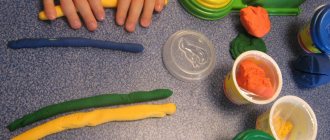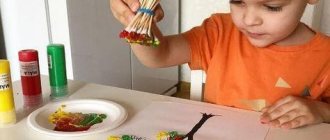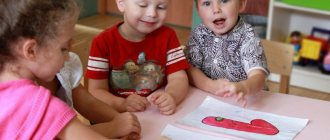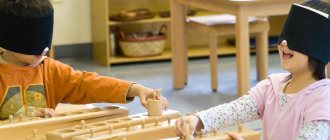Diagnostics of musical development of children
MAP OF MUSICAL DEVELOPMENT OF A PRESCHOOL CHILDREN
Explanatory note
The implementation of the basic educational program of preschool education involves assessing the individual development of the child. This assessment is carried out by teachers as part of pedagogical diagnostics (assessment of the individual development of preschool children, associated with assessing the effectiveness of pedagogical actions and underlying their further planning).
Diagnostics of the musical development of preschool children is carried out in 2 – 6 groups (children’s age from 2 to 7 years) 2 times a year using certain indicators. Indicators and tasks that allow us to judge the dynamics of the development of musical abilities are determined for each age group.
Purpose of diagnosis:
determination of the level of three basic musical abilities in preschoolers: modal sense, musical-auditory concepts, sense of rhythm in order to assess the effectiveness of pedagogical actions and organize correctional work in accordance with the individual characteristics of the child.
The results of pedagogical diagnostics can be used exclusively to solve the following educational problems:
1) individualization of education (including support for the child, building his educational trajectory or professional correction of his developmental characteristics);
2) optimization of work with a group of children.
Diagnostics are carried out over several sessions. Children complete some tasks in small groups, and some individually. Diagnostics are carried out using software material.
The results of the observation are entered into the columns of the map of the preschooler’s musical development.
The observation results are presented in the form of a three-level scale: optimal level, sufficient level, low level:
optimal level
: the child independently copes with the proposed task or with a little help from an adult:
enough level
: the child partially copes with the task with the help of an adult;
low level
: the child cannot cope with tasks, even with the help of an adult.
Method of pedagogical diagnostics
: observation of each child in music classes while performing specially selected tasks.
1st junior group
| No. | Last name, first name of the child | Recognizes familiar melodies and distinguishes the pitch of sounds (high - low) | Together with the teacher, he sings along musical phrases in the song. | Moves in accordance with the nature of the music, begins to move with the first sounds of music | Able to perform movements: stamp your foot, clap your hands, turn your hands | Final indicator (average value) | |||||
Diagnosis of a child’s musical abilities
Diagnosis of the musical abilities of a child with developmental disabilities using the Soundbeam-2 system.
Kozyreva V.P.
Over the past decades, specialists working in the field of pedagogy have noted an increase in the number of cases of complex developmental disorders. The problem of a complex defect is becoming increasingly relevant for modern childhood psychopathology, pathopsychology and correctional pedagogy and forces specialists to think more and more about how to build a system of work with this population.
The inner world of a child with problems is complex. How can we help such children see, hear, feel all the diversity of the environment? How can we help them to know their Self, reveal it and enter the world of adults, fully exist and interact in it? One of the means that can solve all these problems is the art of music.
Art has always occupied an important place in the moral development of society. The role of music in the system of raising children with developmental disabilities is known (A.A. Aidarbekova, I.N. Voropaeva, O.P. Gavrilushkina, I.V. Evtushenko, I.Yu. Levchenko, Z. Mateyova, E.A. Medvedeva, S.M. Milovskaya, E. Seguin).
Music has an amazing power of emotional impact on a person, and any emotion, as is known, is associated with certain reactions in the body. Each piece of music influences various changes in the biochemical processes of the child’s body. The basis of music is sound, an acoustic signal that has a wave structure. It is known from specialized literature that an acoustic signal affects the cells of a living organism, changing their activity. This change can be explained “both by resonant influences on the interested intracellular structures and by electromagnetic field effects” (S.V. Shushardzhan).
Any sound is the feeling (pleasant or unpleasant) that it gives rise to in the listener. The pitch, timbre, intensity, or duration of a sound can evoke pleasant or unpleasant memories or associations. “The temporal organization of sounds gives music form and gives it meaning. It triggers a cognitive process when the performer, composer or listener begins to comprehend the relationships between sounds arranged in such a way as to create a meaningful picture” (D. Alvin, E. Warwick). Music surrounding a child can change his mood and behavior - from apathy to vigorous activity and vice versa. Musical experience can either stimulate or suppress activity, hypnotizing the child. A child's positive reactions to the music he hears or listens to are often unpredictable because his behavior is irrational. However, we can see in the child signs of pleasure or displeasure, the ability to absorb and remember, a desire to repeat the experience or avoid it.
Choosing music for classes with children with severe and multiple developmental disabilities is a difficult task. Some children prefer “live” music played by a teacher. Others like music played on a tape recorder, while others like the musical sounds produced by individual instruments, both traditional and non-traditional. But there are children who simply do not have the ability to express themselves through sounds using conventional instruments.
Traditionally, preschool education uses group music classes, during which the focus is on listening, memorizing and playing music. As a rule, the music director is limited in the use of many musical instruments, musical modes and sound effects. When working with children with multiple developmental disorders, music group classes at the initial stage are not always acceptable due to attention disorders, underdevelopment of intelligence, pathology of the emotional-volitional sphere and for a number of other reasons.
In order to increase the effectiveness of correctional pedagogical work, we conducted an experimental survey and developed a program for the musical education of children with severe developmental disabilities, which provides accessible methods and forms of musical pedagogical influence that stimulate the child for further involvement in the learning environment.
The research was carried out in 2007 on the basis of the children's development center in Moscow. The experimental group consisted of 42 preschool children with various developmental disorders.
All children had medical reports from specialists about their health status: 12 children were diagnosed with early childhood autism, 10 with moderate intellectual disability, and 20 children with combined defects.
The research was carried out in the following areas:
- analysis of medical, psychological and pedagogical documentation;
- studying the speech state of children;
- examination of gross and fine motor functions;
- examination of musical abilities.
The study was conducted in a playful way, individually with each child. The tasks were carried out according to the preliminary demonstration of the researcher.
In the process of completing tasks, we paid special attention to the emotional, communicative and behavioral areas observed in the child. Along with classical tests that determine the state of higher mental functions, we used methods for examining the musical abilities of children.
The results of the study were recorded in the child’s individual record.
The level of development of the child’s musical abilities
General indicators
Emotional responsiveness to music
- responds to live music
- responds to audio recording
- responds to noise instruments
- responds to the sounds of Soundbeam: melodic surrounding world
Gross motor skills
- step at a given pace
- running at the same pace at a given pace
- step in the sound beam
- running in a sound beam
Fine motor skills
- clapping hands
- drum claps
- drumming with fingers
- playing Soundbeam pedals with your palms
- playing Soundbeam pedals with your fingers
Combined actions
- playing Soundbeam with your foot on the pedal, hand on the beam
Musical performing skills
- playing keyboard instruments
- playing children's musical instruments
- sound beam game
- Soundbeam pedal play
Singing
- vocalizations
- singing along
- singing songs
The assessment was carried out using a five-point system. The points scored during the examination were summed up. Based on this, a conclusion was made about the level of the child’s musical abilities, which was the starting point for choosing a methodology for music lessons. We drew up an individual card for accompanying the child and conducted music classes using the Soundbeam-2 system (sound beam).
As a result of our research, four groups of children were conditionally identified depending on the level of development of musical skills.
First group There are no emotional reactions and activity of the child during play activities. Avoids classes and shows indifference to any musical instruments. Shows short-term interest in Soundbeam only as a sounding object.
Second group During the game, negative reactions are noted. The child refuses to play, expressing protest by screaming and throwing musical toys. Reacts briefly to Soundbeam sounds.
Third group The child is not active during play activities. Passively obeys the teacher, is interested in musical instruments, tries to play the Soundbeam. Fourth group
A positive emotional background is observed during gaming activities. When playing on Soundbeam, it tries to repeat the musical sound it likes.
Analysis of the results obtained during the ascertaining experiment allowed us to determine not only the tactics for developing musical abilities, but also to see their place in the construction of correctional pedagogical work as a whole. Individual child support cards were drawn up. For each group, areas of work were identified taking into account the characteristics of each child.
Thus, diagnosing preschoolers with developmental disabilities using the Soundbeam-2 technology will not only make it possible to predict the trend and development potential of the personality trait under study, but also more accurately determine the content of subsequent correctional and pedagogical work.



